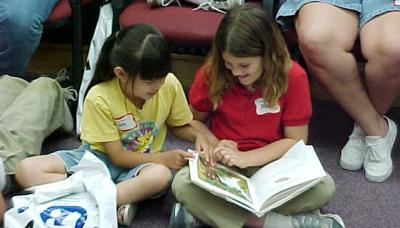It’s the summer programming season, and for most of us, that means audiences will be filled with children and families.

As a one-time child, a mother of two nearly grown children, a reluctant elementary school room mother and a library programmer, I know that being in charge of a room full of excitable, expectant children and their parents can be one of life’s more intimidating experiences. One wandering toddler can send another half dozen pinballing through the room. Children not picked immediately as “special helpers” can have a meltdown, and a couple of chatting parents in the back of the room can ruin the program for everyone.
With that in mind, I asked a group of programming veterans here at the Mid-Continent Public Library (MCPL) for their tips and tricks for handling summer crowds and hosting a successful children’s library program with style and grace.
“You have to have a back pocket full of stuff,” said Jean Tapley, a MCPL storytime specialist who has hosted her share of summer programs and now concentrates on storytimes.
Those pockets can be filled with everything from masking tape and traffic signs to books and camp songs.
Set the Tone
Setting the tone for the event can go a long way to ensuring a program’s success, according to veterans.
Nancy Yeager, a MCPL storytime specialist, starts by greeting children and their parents as they come into the program space.
“I just like to ask general questions like how their summer is going or what they’ve been doing,” said Yeager, who has hosted dozens of children’s programs over the years and now works along with Tapley at MCPL. “It just really sets the tone.”
Both Tapley and Yeager like to play Stop and Go to bring groups together. The game uses a two-sided sign with “stop” printed on one side and “go” on the other. They have kids sing a song, clap their hands or jump. The action starts and stops with the flip of the sign.
“It’s the simplest thing, and it works,” said Yeager. “Even the adults like it.”
Tim Phillips, assistant manager at MCPL’s Riverside Branch, warms up the crowd before the start of the program by asking kids trivia questions related to the program.
“We had 'Digeridoo from Down Under,' and I asked general questions about Australia,” Phillips said, recalling a program about Australian culture and history the branch hosted one summer. “I tossed out some prizes like plastic bouncy balls and Rubik’s Cubes. The kids loved the incentives.”
According to Phillips, it’s important to create and focus the energy in the room before the program starts. This is key to keeping everyone engaged throughout the program.
”Always keep your energy up higher than the audience,” Phillips explained. “I know it sounds tough, but if you can do that for a few minutes, you will have them focused.”
Communicate Expectations and Set Limits
Sharing your expectations for audience behavior during the program is also important.
“We always went through rules at the beginning of the program,” said Chris Eaton, who facilitated children’s programs for many years at MCPL’s Liberty and Woodneath branches. Rules included listening and sitting quietly unless the presenter asked them to participate.
It’s also a good idea to set physical boundaries between the crowd and presenter. Yeager suggested creating lines on the floor with painter’s or masking tape and asking children not to cross them. Handing out carpet squares for them to sit on also works well.
But it’s not just the kids who need to be reminded of how to behave during a library program. Sometimes it’s a good idea to give parents a little refresher. During storytimes, Yeager and Tapley said they remind parents to model good behavior.
“We tell parents, ‘When the kids see that you’re enjoying it, they will enjoy it, too,’” Yeager said. “It puts a little pressure on the parents. They think ‘I need to be good, too.’”
Keep Them Busy
One unique challenge of children and family programs is keeping the rest of the audience engaged as small groups go up to participate in an activity or pet an animal.
“Have the other kids do something while they wait,” Tapley said. “They can snap, clap or beep while the other ones go up. It keeps them busy.”
Be Prepared
It doesn’t happen often, but sometimes a program doesn’t go off exactly as planned. When presenters are running late, everyone suggested having books or games ready for the crowd while they're waiting.
“The book usually pertained to something that the program was about,” Eaton said, “but that was not always true. If I found a really funny book, that was what I shared.”
Other times, she had the crowd sing camp songs.
Be Flexible
Flexibility is probably the most important thing when it comes to working with large groups.
That’s what Yeager learned when her presenter, a Sacagawea re-enactor, announced she’d locked her keys in the car and her part of an American Girl party would be delayed. Yeager scrambled to rearrange the schedule as parents and children started to come in for the program.
“Luckily, we had other activities planned,” said Yeager, who laughs about the incident today. “We just shifted everything around and the program went on.”
Eventually Sacagawea unlocked her car, the girls learned about the heroine of the Corps of Discovery, and everyone had a good time.



